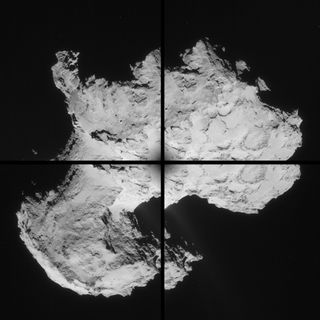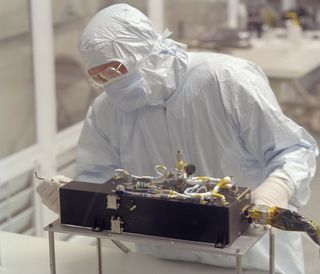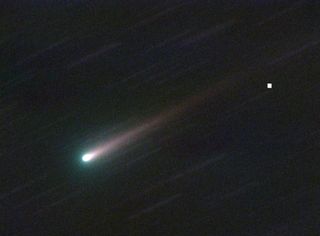Weird Comet Is Darker Than Charcoal
A spacecraft chasing a comet in deep space has found that its target is surprisingly dark in color.
Instead of arriving at a bright, reflective, ice-covered heavenly body, the European Space Agency's Rosetta probe found that its target comet, 67P/Churyumov-Gerasimenko (or 67P/C-G), appears darker than charcoal in some wavelengths of light, according to new data collected by an instrument on the spacecraft. And, so far, scientists working with the Alice instrument on Rosetta have not found any large patches of water-ice on Comet 67P/C-G's surface.
"We're a bit surprised at just how unreflective the comet's surface is and how little evidence of exposed water-ice it shows," Alan Stern, Alice principal investigator at the Southwest Research Institute in Boulder, Colorado, said in a statement. [See photos of comet 67P by Rosetta]

Researchers expected to see ice patches on the surface of the comet because of the body's distance from the sun. At the moment, that distance is so great that the sun can't warm ice on the comet's surface, which would turn it into water vapor; therefore, scientists thought there would be ice patches on the comet's surface, according to NASA.
The comet and Rosetta are currently flying about 318 million miles (512 million kilometers) from the sun, on their way to the comet's closest approach to the star, in August 2015. When Comet 67P/C-G makes its flyby of the sun, Rosetta will be able to measure the way the comet changes. The new data should help researchers learn more about the origin of comets, remnants from the beginnings of the solar system.

"As the mission progresses, we will continue to search for surface ice patches and ultraviolet color and composition variations across the surface of the comet," Lori Feaga, Alice co-investigator at the University of Maryland, said in a statement.
Alice has also identified hydrogen and oxygen in the comet's atmosphere, according to NASA.
Get the Space.com Newsletter
Breaking space news, the latest updates on rocket launches, skywatching events and more!
In November, the Philae lander — currently tucked inside Rosetta — will fly down to the comet's surface to make measurements while attached to Comet 67P/C-G. Scientists are currently examining five potential Philae landing sites in order to decide where the lander should park on the comet's face. The European Space Agency is expected to announce its top choice for a landings site on Sept. 15.
Rosetta launched on its 10-year, 4-billion-mile (6 billion km) journey across the solar system in 2004. The comet-chasing probe caught up to Comet 67P/C-G in August, after arriving about 62 miles (100 km) from the cosmic body. Since then, the spacecraft has been maneuvering, getting closer to the comet in anticipation of releasing the Philae lander down to the comet's surface.
Follow Miriam Kramer @mirikramer and Google+. Follow us @Spacedotcom, Facebook and Google+. Original article on Space.com.

Join our Space Forums to keep talking space on the latest missions, night sky and more! And if you have a news tip, correction or comment, let us know at: community@space.com.

Miriam Kramer joined Space.com as a Staff Writer in December 2012. Since then, she has floated in weightlessness on a zero-gravity flight, felt the pull of 4-Gs in a trainer aircraft and watched rockets soar into space from Florida and Virginia. She also served as Space.com's lead space entertainment reporter, and enjoys all aspects of space news, astronomy and commercial spaceflight. Miriam has also presented space stories during live interviews with Fox News and other TV and radio outlets. She originally hails from Knoxville, Tennessee where she and her family would take trips to dark spots on the outskirts of town to watch meteor showers every year. She loves to travel and one day hopes to see the northern lights in person. Miriam is currently a space reporter with Axios, writing the Axios Space newsletter. You can follow Miriam on Twitter.